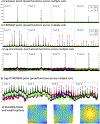3D FRONSAC with PSF reconstruction
- PMID: 37672990
- PMCID: PMC10592039
- DOI: 10.1016/j.jmr.2023.107544
3D FRONSAC with PSF reconstruction
Abstract
Purpose: This study extends the Fast ROtary Nonlinear Spatial ACquisition (FRONSAC) method to include 3D acquisitions and reconstructions. It uses a transform domain reconstruction which is needed to make 3D reconstructions practical and provides new insights into how parallel imaging performance is enhanced by FRONSAC encoding.
Methods: This work developed the first examples of FRONSAC incorporated into a 3D acquisition. 3D FRONSAC was tested on human subjects with both simple gradient echo and MPRAGE Cartesian acquisitions. The quality of the 3D FRONSAC images was evaluated using structural similarity index measure (SSIM), and normalized root mean square error (NRMSE).
Results: FRONSAC encoding did not significantly modify the contrast obtained in either sequence, but it substantially improves the image quality of undersampled reconstruction. FRONSAC images have reduced undersampling ghosts and consistently improved SSIM and NRMSE.
Conclusions: Acquisition and reconstruction of 3D FRONSAC images are feasible, and the additional FRONSAC encoding improves image quality in highly undersampled images.
Keywords: Accelerated imaging; Nonlinear gradients; Parallel imaging.
Copyright © 2023 Elsevier Inc. All rights reserved.
Conflict of interest statement
Declaration of Competing Interest The authors declare the following financial interests/personal relationships which may be considered as potential competing interests: [Gigi Galiana reports financial support was provided by National Institute of Health.].
Figures






References
Publication types
MeSH terms
Grants and funding
LinkOut - more resources
Full Text Sources

